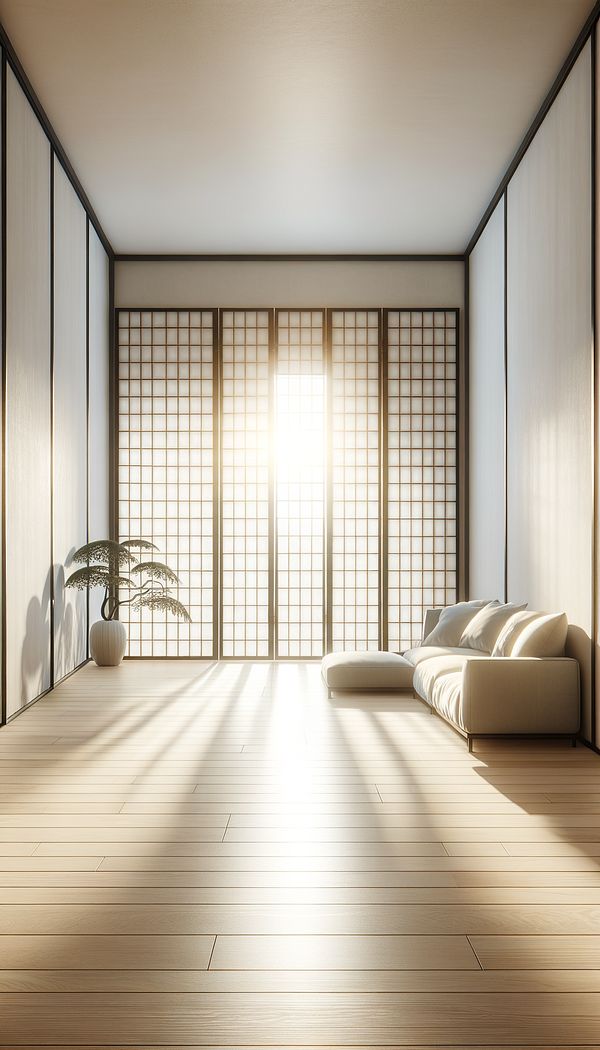What is Shoji?
Shoji refers to a traditional Japanese sliding panel that separates spaces or serves as a door or window.
Description
At heart, Shoji embodies the elegance and minimalist aesthetic hallmarks of traditional Japanese interior design. These sliding panels consist of a lightweight wooden frame fitted with translucent paper, allowing light to filter through while offering privacy. This delicate balance between functionality and aesthetic appeal makes Shoji a popular choice for those seeking to infuse a sense of calm and simplicity into their spaces.
Shoji screens traditionally use washi, a durable Japanese paper, which contributes to their distinctive look and feel. While they serve practical purposes such as room division and light diffusion, Shoji panels also play a significant role in the overall aesthetic of a space, enhancing a room's natural light and providing a seamless indoor-outdoor flow. Modern applications of Shoji have adapted the traditional concept to various materials, including glass and plastics, ensuring durability while maintaining the screen's intrinsic beauty. These adaptations make Shoji suitable for a wide range of interior design styles beyond the traditional Japanese setting.
Incorporating Shoji into a contemporary home can offer both visual and functional benefits. It can help create versatile spaces that adapt to different needs, from providing privacy in a shared living area to creating a serene, well-lit workspace. Furthermore, Shoji panels contribute to a more sustainable design approach by utilizing natural light more effectively and reducing the need for artificial lighting.
Usage
Shoji is commonly used in residential and commercial spaces looking to achieve a blend of traditional Japanese aesthetics with modern functionality. These panels can be found as room dividers in living rooms, as doors for closets or bathrooms, and as window coverings that softly diffuse light. The adaptability of Shoji allows it to be a practical solution for various space-planning needs, including open-plan living areas and compact urban apartments. In commercial settings, Shoji panels enhance the ambiance of spaces such as spas, restaurants, and boutique hotels, providing a unique aesthetic touch.
FAQs
-
Can Shoji panels be used in non-Japanese style interiors?
Yes, Shoji panels can be seamlessly integrated into various interior design styles, including modern, minimalist, and even rustic interiors. Their simple, clean lines and the soft light diffusion they offer can complement a wide range of decors.
-
Are modern Shoji panels made only from paper?
No, modern Shoji panels can be made from a variety of materials, including glass, acrylic, and durable plastics designed to simulate the effect of traditional washi paper while offering greater durability and easy maintenance.
-
How do you maintain Shoji panels?
Maintaining Shoji panels typically involves regular dusting and gentle cleaning with a soft, damp cloth. For traditional paper panels, it's important to avoid moisture and direct sunlight to prevent damage. Modern materials may allow for more robust cleaning methods.
Practical Application
When incorporating Shoji panels into your interior design, consider their placement in relation to natural light sources to maximize their light-diffusing capabilities. For a contemporary twist, explore different materials and patterns that can add a unique touch to the traditional design. Remember, the key to using Shoji successfully lies in balancing aesthetics and functionality—use them to create flexible spaces that can change according to your needs.
-
Architectural Elements199 articles
-
Design Styles478 articles
-
Window Treatments65 articles
-
Space Planning & Layout134 articles
-
Materials & Textiles360 articles
-
Night StandA small table or cabinet designed to stand beside a bed.
-
Palladian WindowA Palladian Window is a large window that is divided into three parts, with a semicircular arch over the central section.
-
OrmoluOrmolu is a method of gilding that involves applying finely ground, high-carat gold to a bronze object.
-
Built-inBuilt-in refers to any feature or piece of furniture that is permanently integrated into a room's structure.
-
WebbingWebbing is a strong, flexible strip of fabric used in furniture construction.
